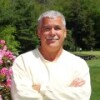ORLANDO — Shawn Emerson spent 25 years in the Arizona sunshine at Desert Mountain Golf Club as the director of agronomy for seven golf courses. There are few better in the industry to debate the pros and cons of overseeding versus painting fairways, tee boxes and greens than Emerson.
Now an agronomy associate and consultant with Ethos Club and Leisure in Mooresville, North Carolina, Emerson has studied the underlying numbers for a decade now and has concluded that painting when Bermudagrass goes dormant is the prudent move for most.
A place like Pinehurst Resort no longer overseeds in the winter months, and Emerson estimates that out of 300 Arizona courses as many as 75 to 100 are now painting.
"And that number is increasing every year," says Emerson, who is attending the Golf Course Superintendents Association of America's annual Conference and Trade Show.

Once frost hits, Bermudagrass turns brown until it re-emerges in the spring in such states as Arizona, parts of California, Nevada, Texas, North Carolina and South Carolina.
The push to overseed with ryegrass for more than three decades in Arizona was purely for ascetics.
"Arizona started overseeding because it was a destination location and the people expected it," Emerson says. "If you are going to get somebody from Minnesota or Chicago and those parts of the world to come to Arizona, they didn’t want to play on brown turf. If it’s brown to them, it’s dead, but of course we call it dormant. So we overseeded.
"The mistake we made with overseeding was we kept stretching it. It was more than overseeding, it became more the primary turf. I’ve done it all — 100 percent, partial overseeding, but if you have a $3 or $4 million house on the golf course people wanted their "backyard" green.”
Emerson said Arizona overseeding started at 400 pounds of seed to an acre and increased to as much as 800 pounds or more per acre. It became ultra expensive.
"And what happened was the vigor of the ryegrass made transition very difficult," he says. "So the summer conditions suffered. Well, who played a lot in the summer? Well, the year-round person, so now we had a battle with conditions for the tourism and destination golfer versus the person who lived there year round."
Emerson noted that painting began to emerge in 2008 when the economy stalled and golfers weren’t traveling as much to resort destinations.
"At that same time sports fields led the way, panting their fields for the Super Bowl and things like that," he says.
Emerson soon found out that by painting his courses he could save between 20% and 30% versus overseeding. That savings was hard to pass up.
"When you paint, you don’t have to mow," he says. "It’s less operation expenses. I could reduce 20-30 percent of my crew because I didn’t mow November to February. I didn’t have to fertilize and there were all these other things. The paint is fairly expensive, but it would offset the seed because the cost is very similar. But I didn’t have to do all these agronomic practices to do it, so painting became very popular."
Emerson estimates painting a golf course costs around $100,000 to $150,000 less than overseeding.
"We’re learning how to produce the best painted golf courses that look realistic," Emerson says. "They used to look a little blueish because it was a dye and not a paint. So all this evolution is happening through the technologies we’re developing."
Once such company is US Specialty Coatings in Alpharetta, Georgia — a firm that has been around for four decades.
"It has become very popular," says Herman Irani, president of USSC. "I am a chemist so it was brought to our attention 15 years ago to make something like this for golf courses.

"One product is like a paint that has a binder in it. It binds to the blades of grass. It is a concentrated paint. There are several shades depending on what part of the country you are in and it will match your shade of grass and it looks natural. When the grass comes back from its dormancy it will grow back no problem."
A second coloring option is a pigment that is used when grass is still growing. It's more cost effective than painting, but it may not remain green looking through the winter.
"The pigment is absorbed into the blades of the grass and it makes the grass look healthy but you may have to apply it two or three times,” Irani says.
Sure, there has been a learning curve on painting for most golf course superintendents who have taken that route, but Emerson believes the trend is here to stay.
"Golf is green — for the economy, for the environment and green for the dollar, so whatever works best, and those are the decisions people have to make,” he says. “The question was if you painted would you lose revenue? Well, maybe you don’t charge as much money per round but that’s offset by less operational costs, so in the end it may be a gain.”











